
| Version | Summary | Created by | Modification | Content Size | Created at | Operation |
|---|---|---|---|---|---|---|
| 1 | Sirius Huang | -- | 2555 | 2022-11-03 01:36:44 |
Video Upload Options
The House of Bonaparte (originally Buonaparte) was an imperial and royal European dynasty founded in 1804 by Italian noble Carlo Buonaparte and his son Napoleon I, a French military leader of Italian heritage who had risen to notability out of the French Revolution and who in 1804 transformed the First French Republic into the First French Empire, five years after his coup d'état of November 1799. Napoleon turned the Grande Armée against every major European power and dominated continental Europe through a series of military victories during the Napoleonic Wars. He installed members of his family on the thrones of client states, extending the power of the dynasty. The House of Bonaparte formed the Imperial House of France during the French Empire, together with some non-Bonaparte family members. In addition to holding the title of Emperor of the French, the Bonaparte dynasty held various other titles and territories during the Napoleonic Wars, including their ancestral Kingdom of Italy, the Kingdom of Spain, the Kingdom of Westphalia, the Kingdom of Holland, and the Kingdom of Naples. The dynasty held power for around a decade until the Napoleonic Wars began to take their toll. Making very powerful enemies, such as Austria, Britain, Russia, and Prussia, as well as royalist (particularly Bourbon) restorational movements in France, Spain, the Two Sicilies, and Sardinia, the dynasty eventually collapsed due to the final defeat of Napoleon at the Battle of Waterloo and the restoration of former dynasties by the Congress of Vienna. During the reign of Napoleon I, the Imperial Family consisted of the Emperor's immediate relations – his wife, son, siblings, and some other close relatives, namely Joachim Murat, Joseph Fesch, and Eugène de Beauharnais. Between 1852 and 1870, there was a Second French Empire, when a member of the Bonaparte dynasty again ruled France: Napoleon III, the youngest son of Louis Bonaparte. However, during the Franco-Prussian War of 1870–1871, the dynasty was again ousted from the Imperial Throne. Since that time, there has been a series of pretenders. Supporters of the Bonaparte family's claim to the throne of France are known as Bonapartists. Current head Jean-Christophe, Prince Napoléon, has a Bourbon mother.
1. Italian Origins
The Bonaparte (originally Buonaparte) family were patricians in the Italian towns of Sarzana, San Miniato and Florence. The name derives from Italian: buona ("good") and parte ("part" or "side").
Gianfaldo Buonaparte was the first known Buonaparte at Sarzana around 1200. His descendant Giovanni Buonaparte in 1397 married Isabella Calandrini, a cousin of later cardinal Filippo Calandrini. Giovanni became mayor of Sarzana and was named commissioner of the Lunigiana by Giovanni Maria Visconti in 1408. Their great-grandson Francesco Buonaparte was an equestrian mercenary at the service of the Genoese Bank of Saint George. In 1490, he went to the island of Corsica, which was controlled by the bank. In 1493, he married the daughter of Guido da Castelletto, representative of the Bank of Saint George in Ajaccio, Corsica. Most of their descendants during subsequent generations were members of the Ajaccio town council. Napoleon's father, Carlo Buonaparte, received a patent of nobility from the King of France in 1771.
There also existed a Buonaparte family in Florence, however its eventual relation with the Sarzana and San Miniato families is unknown. Jacopo Buonaparte of San Miniato was a friend and advisor to Medici Pope Clement VII. Jacopo was also a witness to and wrote an account of the sack of Rome, which is one of the most important historical documents recounting that event.[1] Two of Jacopo's nephews, Pier Antonio Buonaparte and Giovanni Buonaparte, however, took part in the 1527 Medici rebellion, after which they were banished from Florence and later were restored by Alessandro de' Medici, Duke of Florence. Jacopo's brother Benedetto Buonaparte maintained political neutrality.[2] The San Miniato branch extinguished with Jacopo in 1550. The last member of the Florence family was a canon named Gregorio Bonaparte, who died in 1803, leaving Napoleon as heir.[3]
A Buonaparte tomb lies in the Church of San Francesco in San Miniato. Another in Ajaccio, the Chapelle Impériale, was built by Napoleon III in 1857.
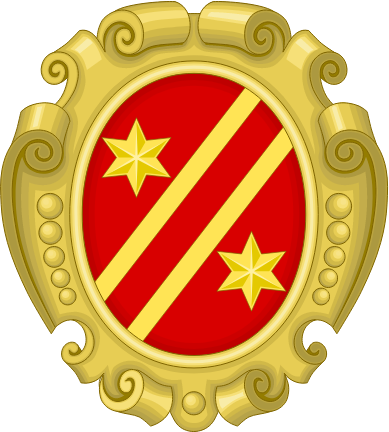
Coat of arms of the Buonaparte of Sarzana. https://handwiki.org/wiki/index.php?curid=2074707
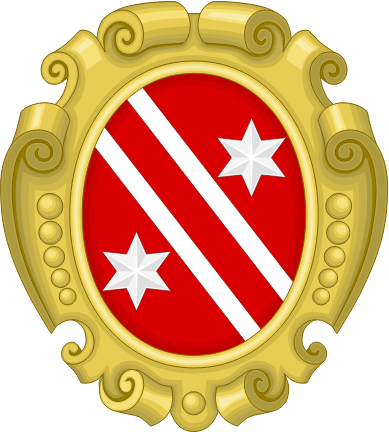
Coat of arms of the Buonaparte of San Miniato. https://handwiki.org/wiki/index.php?curid=2058188

Coat of arms of the Buonaparte of Florence. https://handwiki.org/wiki/index.php?curid=2068402
2. Imperial House of France
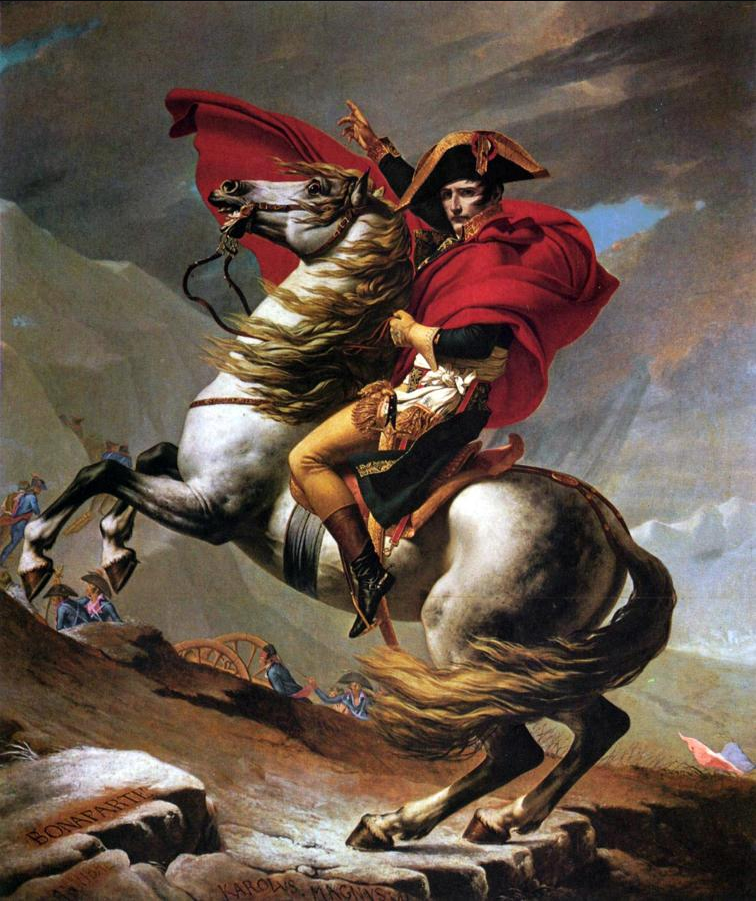
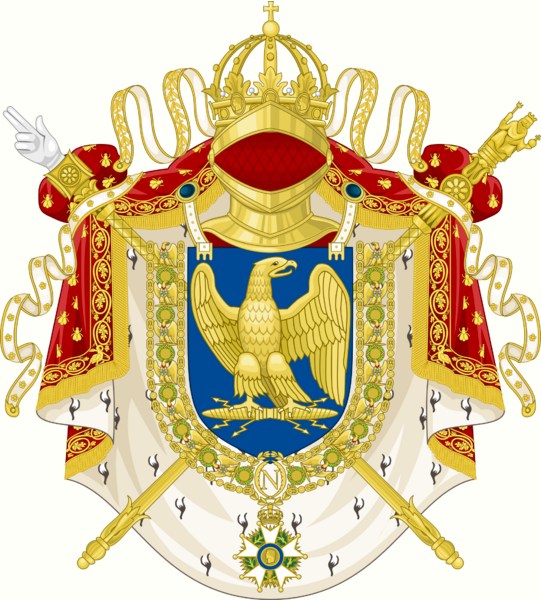
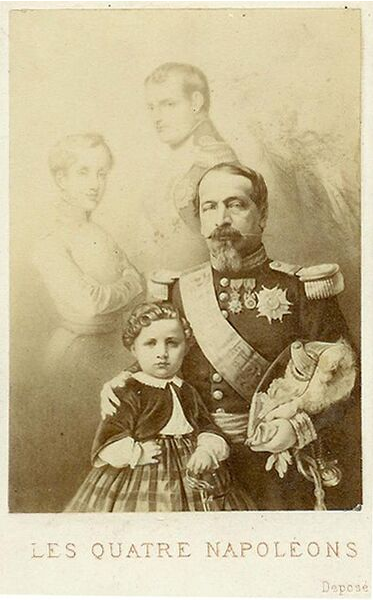
Napoleon I is the most prominent name associated with the Bonaparte family, because he conquered much of Europe during the early part of the 19th century. Due to his indisputable popularity in France both among the people and in the army, he successfully took part in the Coup of 18 Brumaire, overthrew the Directory with the help of his brother, Lucien Bonaparte, president of the Council of Five Hundred, and participated in the creation of a new Constitution, which allowed him to become the First Consul of France on 10 November 1799. 2 December 1804, he crowned himself Emperor of the French and ruled from 1804 to 1814, and again in 1815 during the Hundred Days after his return from Elba.
Following his conquest of most of Western Europe, Napoleon I made his elder brother Joseph (1768–1844) king first of Naples (1806–1808) and then of Spain (1808–1813), his younger brother Louis (1778–1846) King of Holland (1806–1810; subsequently forcing his abdication after his failure to subordinate Dutch interests to those of France), and his youngest brother Jérôme (1784–1860) King of Westphalia, the short-lived realm created from some of the states of northwestern Germany (1807–1813).
Napoleon's son Napoléon François Charles Joseph (1811–1832) was created King of Rome (1811–1814) and was later styled as Napoléon II by loyalists of the dynasty, though he only ruled for two weeks after his father's abdication.
Louis-Napoléon (1808–1873), son of Louis, was President of France (1848–1852) and then Emperor of the French (1852–1870), reigning as Napoleon III. His son, Napoléon, Prince Imperial (1856–1879), died fighting the Zulus in Natal, today the South African province of KwaZulu-Natal. With his death, the family lost much of its remaining political appeal, though claimants continue to assert their right to the imperial title. A political movement for Corsican independence surfaced in the 1990s which included a Bonapartist restoration in its programme.
3. Crowns Held by the Family
3.1. Emperors of the French
- Napoleon I (1804–1814, 1815), also King of Italy (1805–1814) and Emperor in Elba (1814–1815) and Co-Prince of Andorra (1804–1814, 1815)
- Napoleon II (1815), styled as King of Rome from birth, but never reigned and also Duke of Reichstadt 1818–1832, but never visited the town)
- Napoleon III (1852–1870), also Co-Prince of Andorra (1852–1870)
3.2. Kings of Holland
- Louis I (1806–1810)
- Louis II (1810), also Grand Duke of Berg (1809–1813)
3.3. King of Naples
- Joseph I (1806–1808)
3.4. King of Westphalia
- Jérôme I (1807–1813)
3.5. King of Spain
- Joseph I (1808–1813)
3.6. Grand Duchess of Tuscany
- Elisa Bonaparte (1809–1814), also Princess of Lucca and Piombino (1805–1814)
4. Heads of the House of Bonaparte (Since 1852)
- Napoléon III (1852–1873)
- Napoléon IV Eugène (1873–1879), son of Napoléon III
- Napoléon V Victor (1879–1926), grandson of Napoléon I's youngest brother, Jérôme Bonaparte
- Napoléon VI Louis (1926–1997), son of Napoléon V Victor
Disputed since 1997:
- Napoléon VII Charles (1997–present), son of Napoléon VI Louis
- Napoléon VII Jean-Christophe (1997–present), grandson of Napoléon VI Louis
5. The Family Tree
Carlo-Maria (Ajaccio, 1746–Montpellier, 1785) married Maria Letizia Ramolino (Ajaccio, 1750–Rome, 1836) in 1764. He was a minor official in the local courts. They had eight children:
- Joseph Bonaparte (Corte, 1768–Florence, 1844), King of Naples, then King of Spain, married Julie Clary, sister of Napoleon's childhood sweetheart, Désirée, who was to become the wife of General Jean-Baptiste Bernadotte (later Charles XIV, King of Sweden)
- Julie Joséphine Bonaparte (1796–1796)
- Zénaïde Laetitia Julie Bonaparte (1801–1854)
- Charlotte Napoléone Bonaparte (1802–1839)
- Napoléon (I) Bonaparte (1769–1821) Emperor of the French
- Napoléon (II) François Joseph Charles Bonaparte (1811–1832), Prince Imperial, King of Rome, Prince of Parma, son of Archduchess Marie Louise of Austria (of the Habsburg dynasty), Empress consort, then Duchess of Parma
- Lucien Bonaparte (1775–1840) Roman Prince of Canino and Musignano
- 3 daughters with first wife, Christine Boyer:
- Charlotte Christine Bonaparte (1795–1865), married Prince Mario Gabrielli
- Victoire Gertrude Bonaparte (1797–1797)
- Christine Charlotte Alexandrine Egypta Bonaparte (1798–1847), married Count Arvid Posse, then married Lord Dudley Stuart
- 10 children with second wife, Alexandrine de Bleschamp:
- Charles Lucien Jules Laurent Bonaparte (1803–1857), ornithologist and politician married Princess Zénaïde Bonaparte (1801–1854)
- Joseph Lucien Charles Napoléon Bonaparte (1824–1865)
- Alexandrine Gertrude Zénaïde Bonaparte (1826–1828)
- Lucien Louis Joseph Napoléon (Cardinal) Bonaparte (1828–1895)
- Julie Charlotte Pauline Zénaïde Laetitia Désirée Bartholomée Bonaparte (1830–1900)
- Charlotte Honorine Joséphine Pauline Bonaparte (1832–1901)
- Léonie Stéphanie Elise Bonaparte (1833–1839)
- Marie Désirée Eugénie Joséphine Philomène Bonaparte (1835–1890)
- Augusta Amélie Maximilienne Jacqueline Bonaparte (1836–1900)
- Napoléon Charles Grégoire Jacques Philippe Bonaparte (1839–1899)
- Zénaïde Victoire Eugénie Bonaparte (1860–1862)
- Marie Léonie Eugénie Mathilde Jeanne Julie Zénaïde Bonaparte (1870–1947)
- Eugénie Laetitia Barbe Caroline Lucienne Marie Jeanne Bonaparte (1872–1949)
- Bathilde Aloïse Léonie Bonaparte (1840–1861)
- Albertine Marie Thérèse Bonaparte (1842–1842)
- Charles Albert Edmond Bonaparte (1843–1847)
- Laetitia Christine Bonaparte (1804–1871)
- Joseph Lucien Bonaparte (1806–1807)
- Jeanne Adélaïde Bonaparte (1807–1829)
- Paul Marie Bonaparte (1808–1827)
- Louis Lucien Bonaparte (1813–1891)
- Pierre Napoléon Bonaparte (1815–1881)
- Roland Bonaparte (1858–1924) married Marie Blanc
- Princess Marie Bonaparte (1882–1962) married Prince George of Greece
- Princess Jeanne Bonaparte (1861–1910)
- Roland Bonaparte (1858–1924) married Marie Blanc
- Antoine Lucien Bonaparte (1816–1877)
- Alexandrine Marie Bonaparte (1818–1874)
- Constance Marie Bonaparte (1823–1876)
- Charles Lucien Jules Laurent Bonaparte (1803–1857), ornithologist and politician married Princess Zénaïde Bonaparte (1801–1854)
- 3 daughters with first wife, Christine Boyer:
- Maria-Anna Elisa Bonaparte (1777–1820), Grand-Duchess of Tuscany, married Félix Baciocchi Levoy, Prince of Lucca
- Marie-Laetitia Bonaparte Baciocchi Levoy
- Louis Bonaparte (1778–1846), King of Holland, married Hortense de Beauharnais, Napoleon's stepdaughter
- Napoléon Charles Bonaparte (1802–1807)
- Napoléon Louis Bonaparte (1804–1831)
- Charles Louis Napoléon (III) Bonaparte (1808–1873) Emperor of the French, married Maria Eugenia Ignacia Augustina Palafox de Guzmán Portocarrero y Kirkpatrick
- Napoléon Eugène Louis John Joseph Bonaparte, Prince Imperial (1856–1879)
- Maria Paola or Marie Pauline Bonaparte (1780–1825) Princess and Duchess of Guastalla, married in 1797 to French General Charles Leclerc and later married Camillo Borghese, 6th Prince of Sulmona.
- Maria Annunziata Caroline Bonaparte (1782–1839) married Joachim Murat, Marshal of France, Grand Duke of Berg, then King of Naples
- Prince Achille Murat (1801–1847), married Catherine Willis Gray (1803–1867), great-grandniece of George Washington.
- Prince Napoléon Lucien Charles Murat (1803–1878), married Caroline Georgina Fraser (1810–1879).
- 5 Children, including:
- Joachim Joseph Napoléon Murat, 4th Prince Murat (1834–1901), Major-General of the French Army, married firstly Malcy Louise Caroline Berthier de Wagram (1832–1884) and had issue, and secondly Lydia Hervey, without issue.
- Prince Louis Napoléon Murat (1851–1912), married in Odessa, Eudoxia Mikhailovna Somova (1850–1924), had issue now extinct in male line.
- Jérôme Bonaparte (1784–1860), King of Westphalia
- 1 child from first marriage, to Betsy Patterson of Baltimore:
- Jérôme Napoléon Bonaparte (1805–1870), married Susan May Williams and had 2 sons :
- Jerome Napoleon Bonaparte II (1830–1893), married Caroline Le Roy Appleton Edgar
- Louise-Eugénie Bonaparte (1873–1923), married in 1896 Count Adam Carl von Moltke-Huitfeld (1864–1944); numerous descendants
- Jerome Napoléon Charles Bonaparte III (1878–1945), married Blanche Pierce Stenbeigh, no posterity
- Charles Joseph Bonaparte (1851–1921), United States Secretary of the Navy and United States Attorney General, married Ellen Channing Day, no issue
- Jerome Napoleon Bonaparte II (1830–1893), married Caroline Le Roy Appleton Edgar
- Jérôme Napoléon Bonaparte (1805–1870), married Susan May Williams and had 2 sons :
- 3 children from second marriage, to Princess Catharina of Württemberg:
- Jérôme Napoléon Charles Bonaparte I (1814–1847), unmarried and childless
- Mathilde Laetitia Wilhelmine Bonaparte (1820–1904), married Anatoly Nikolaievich Demidov, 1st Prince of San Donato: no posterity
- Napoléon Joseph Charles Paul Bonaparte, Prince Napoléon (1822–1891), called Plon-Plon married Princess Marie Clothilde of Savoy daughter of Victor Emmanuel II of Italy
- Napoléon Victor Jérôme Frédéric Bonaparte, Prince Napoléon (1862–1926) married Princess Clémentine of Belgium
- Marie Clotilde Eugénie Alberte Laetitia Geneviève Bonaparte (1912–1996) married Count Serge de Witt
- Louis Jérôme Victor Emmanuel Léopold Marie Bonaparte, Prince Napoléon (1914–1997), married Alix de Foresta
- Charles Marie Jérôme Victor Bonaparte, Prince Napoléon (born 1950)
- Two children from first marriage, to Princess Béatrice of Bourbon-Two Sicilies of the Bourbon family:
- Caroline Marie Constance Bonaparte (Princess Caroline Napoléon) (born 1980)
- Jean-Christophe Louis Ferdinand Albéric Bonaparte, Prince Napoléon (born 1986)
- 1 child and 1 adopted child from second marriage, to Jeanne-Françoise Valliccioni (born 1958):
- Sophie Catherine Bonaparte (born 1992)
- Anh Laëtitia Bonaparte (born 1998, adopted)
- Two children from first marriage, to Princess Béatrice of Bourbon-Two Sicilies of the Bourbon family:
- Catherine Elisabeth Albérique Marie Bonaparte (born 1950)
- Laure Clémentine Geneviève Bonaparte (born 1952)
- Jérôme Xavier Marie Joseph Victor Bonaparte (Prince Jérôme Napoléon) (born 1957), married in 2013 with Licia Innocenti
- Charles Marie Jérôme Victor Bonaparte, Prince Napoléon (born 1950)
- Napoléon Louis Joseph Jérôme Bonaparte (1864–1932) Russian General, unmarried and childless
- Marie Laetitia Eugénie Catherine Adélaïde Bonaparte (1866–1926) married Prince Amedeo of Savoy, Duke of Aosta
- Napoléon Victor Jérôme Frédéric Bonaparte, Prince Napoléon (1862–1926) married Princess Clémentine of Belgium
- 1 child from first marriage, to Betsy Patterson of Baltimore:
6. Bonaparte Arms
The arms of the Bonaparte family were: Gules two bends sinister between two mullets or. In 1804, Napoleon I changed the arms to Azure an imperial eagle or. The change applied to all members of his family except for his brother Lucien and his nephew, the son from Jerome's first marriage.
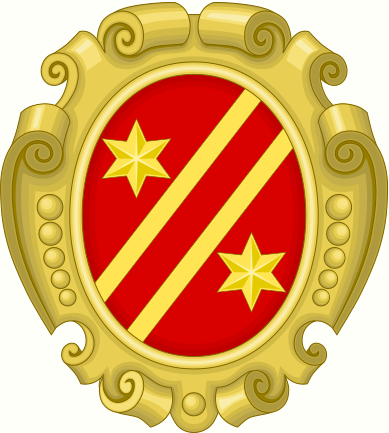
Arms of Charles-Maria Buonaparte. https://handwiki.org/wiki/index.php?curid=2074707

Arms of Napoleon I and Napoleon II, as Emperor of the French. https://handwiki.org/wiki/index.php?curid=2058188
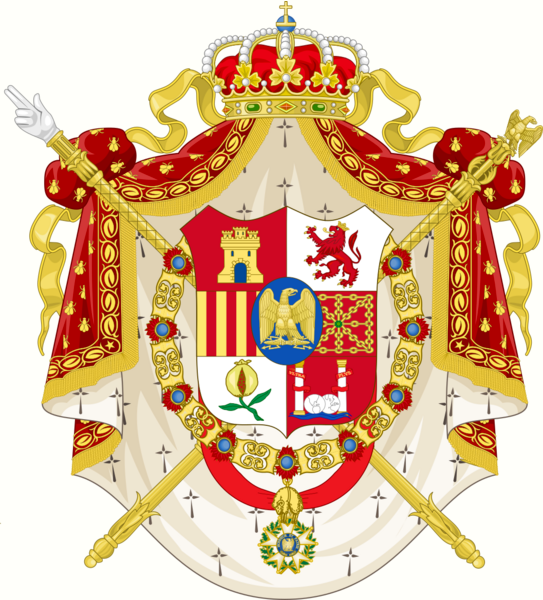
Arms of Joseph Bonaparte, King of Spain. https://handwiki.org/wiki/index.php?curid=2017854
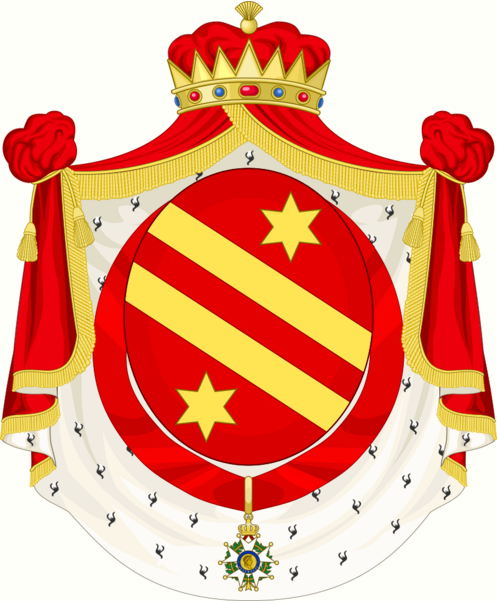
Arms of Lucien Bonaparte, Prince of Canino and Musignano. https://handwiki.org/wiki/index.php?curid=1999223
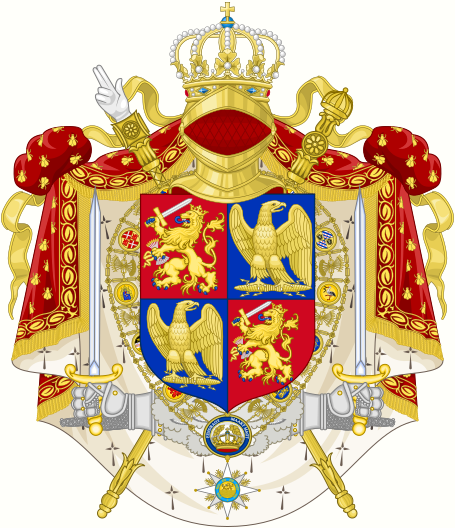
Arms of Louis Bonaparte, King of Holland. https://handwiki.org/wiki/index.php?curid=2023833
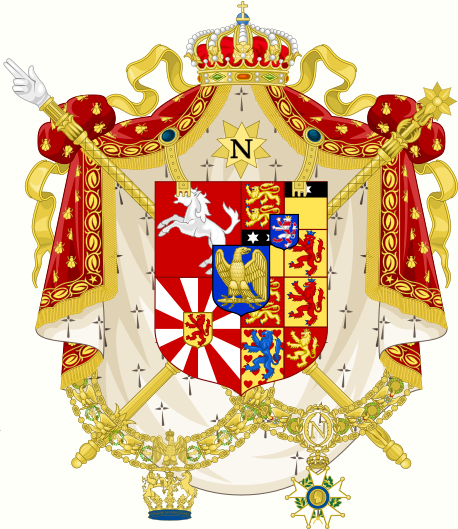
Arms of Jérôme Bonaparte, King of Westphalia. https://handwiki.org/wiki/index.php?curid=1995089
7. DNA Research
According to studies by G. Lucotte and his coauthors based on DNA research since 2011, Napoleon Bonaparte belonged to Y-DNA (direct male ancestry) haplogroup E1b1b1c1* (E-M34*). This haplogroup, rare in Europe, has its highest concentration in Ethiopia and in the Near East (Jordan, Yemen). According to the authors of the study, "Probably Napoléon also knew his remote oriental patrilineal origins, because Francesco Buonaparte (the Giovanni son), who was a mercenary under the orders of the Genoa Republic in Ajaccio in 1490, was nicknamed The Maure of Sarzane." The latest study identifies the common Bonaparte DNA markers from Carlo (Charles) Bonaparte to 3 living descendants.[4][5]
Lucotte et al. published in October 2013 the extended Y-STR of Napoleon I based on descendant testing, and the descendants were E-M34, just like the emperor's beard hair tested a year before. The persons tested were the patrilineal descendants of Jérome Bonaparte, one of Napoleon's brothers, and of Alexandre Colonna-Walewski, Napoleon's illegitimate son with Marie Walewska. These three tests all yielded the same Y-STR haplotype (109 markers) confirming with 100% certainty that the first Emperor of the French belonged to the M34 branch of haplogroup E1b1b.
8. Living Members
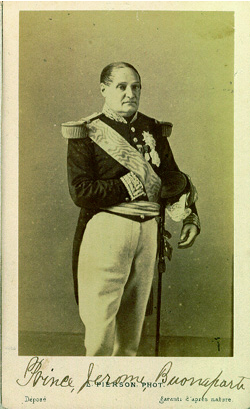
The current headship of the family is in dispute between Charles, Prince Napoléon (born 1950), great-great-grandson of Jérôme Bonaparte by his second marriage, and his son Jean-Christophe, Prince Napoléon (born 1986), who was appointed heir in the will of his grandfather Louis, Prince Napoléon.[6] The only other male member of the family is Charles's recently married brother, Prince Jérôme Napoléon (born 1957). There are no other legitimate descendants in the male line from Napoleon I or his brothers.
There are, however, numerous descendants of Napoleon's illegitimate but recognized son, Alexandre Colonna-Walewski, from his union with Marie, Countess Walewski. A descendant of Napoleon's sister Caroline Bonaparte is the actor René Auberjonois. Recent DNA matches with living descendants of Jérôme and Count Walewski have confirmed the existence of descendants of Lucien Bonaparte, Napoleon's brother, namely the Clovis family.[5]
References
- Jacopo Bonaparte: Sac de Rome. Écrit EN 1527 par Jacques Bonaparte. Témoin oculaire, hrsgg. by Bonaparte, Napoléon Louis, Florenz 1850
- Drake, Joshua F. (October 2005). "The partbooks of a Florentine ex-patriate: new light on Florence, Biblioteca Nazionale Centrale Ms. Magl. XIX 164–7". Early Music 33 (4): 639–646. doi:10.1093/em/cah154. http://em.oxfordjournals.org/cgi/content/abstract/33/4/639.
- Burke, Sir Bernard (1869). Vicissitudes of Families. London: Longmans, Green, Reader, and Dye. https://books.google.com/books?id=HSYwAAAAYAAJ&printsec=frontcover&source=gbs_ge_summary_r&cad=0#v=onepage&q&f=false.
- Lucotte, Gerard; Thomasset, Thierry; Hrechdakian, Peter (2011). "Haplogroup of the Y Chromosome of Napoléon the First". Journal of Molecular Biology Research 1 (1). doi:10.5539/jmbr.v1n1p12. http://www.ccsenet.org/journal/index.php/jmbr/article/view/10609.
- Lucotte, Gerard; Hrechdakian, Peter (2015). "New Advances Reconstructing the Y Chromosome Haplotype of Napoleon the First Based on Three of his Living Descendants". Journal of Molecular Biology Research 5 (1). doi:10.5539/jmbr.v5n1p1. https://dx.doi.org/10.5539%2Fjmbr.v5n1p1
- Herbert, Susannah (12 March 1997). "Father and son in battle for the Napoléonic succession". The Daily Telegraph (London). https://www.telegraph.co.uk/htmlContent.jhtml?html=/archive/1997/12/03/wnap03.html. Retrieved 4 June 2007.




